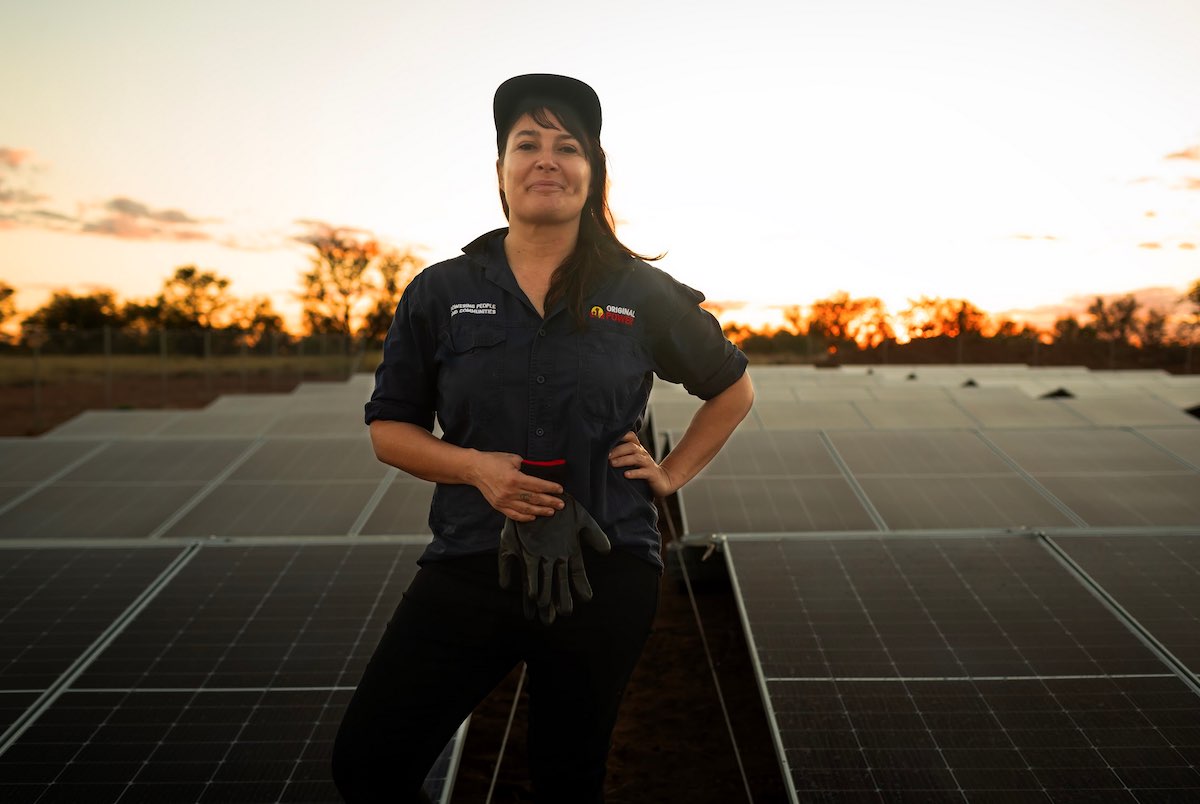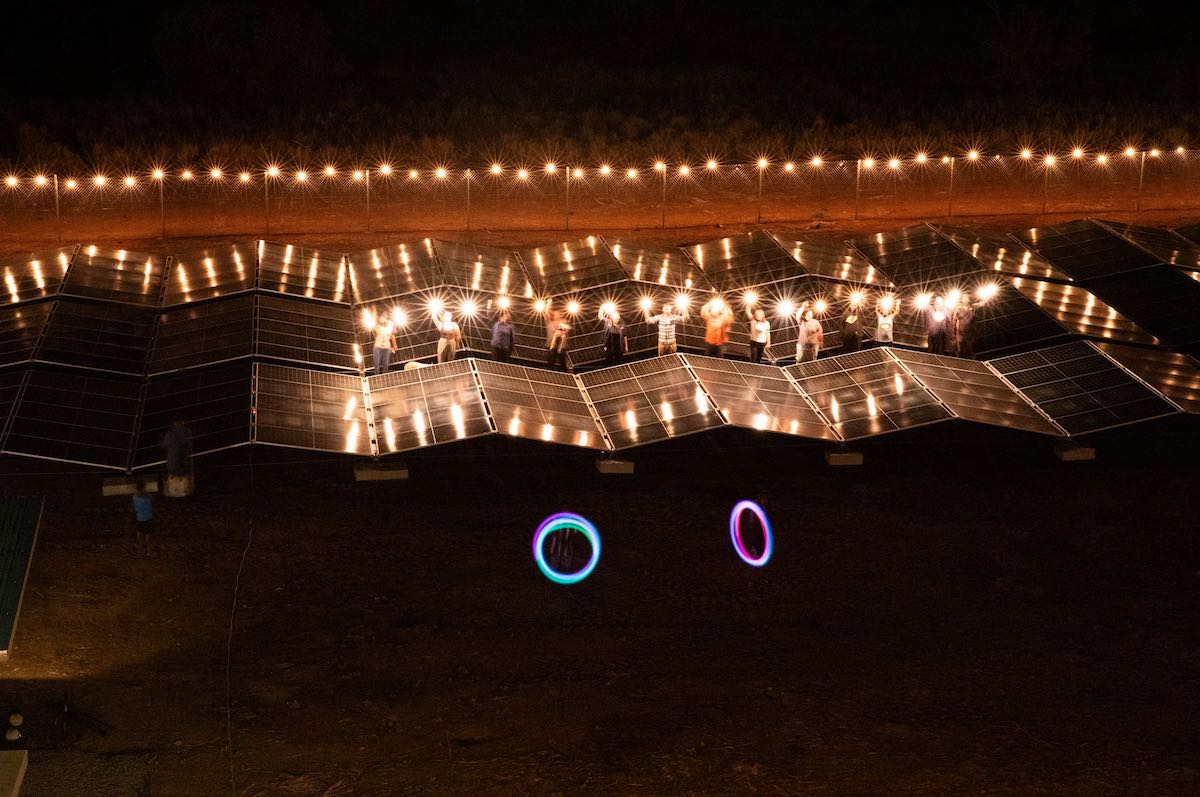
An innovative project to share solar power directly with households in a remote indigenous community – giving them cheaper and more reliable electricity and a stake in Australia’s renewable energy transition – has been launched in the Northern Territory’s Barkly region.
Based around a network-connected 100kW solar array and 136kWh battery, the Marlinja Microgrid is a trailblazing project that has been five years in the making, led by indigenous-owned not-for profit Original Power and the Marlinja community.

Original Power community project coordinator Lauren Mellor says the town approached the company in 2019 with some “very deep energy insecurity challenges” – challenges that, to our governments’ collective shame, are all too common for First Nations communities.
Marlinja, located about halfway between Alice Springs and Darwin, is home to the Jingili people. Essential services for the remote town are supplied by the NT government-owned Power and Water Corporation (PWC) and Jacana Energy is the retailer.
For power, the community’s 60 residents and 18 households rely on a 25km feeder line from a diesel/gas hybrid plant in the nearby township of Elliott.
But like many Aboriginal communities in the Territory, access to that electricity also comes via an NT government mandated prepayment meter system.
As Mellor explains, this means that unlike post-paid billing customers, Marlinja residents need to go to the store to purchase top-up credits to keep up their power supply. If they run out of money, or time, the power goes off.

For households in Marlinja, it is not uncommon to have the power cut off every three days. This can last for periods of up to eight hours, or sometimes days at a time, until they can afford to top up their meters.
On average, Mellor says residents in Marlinja were spending about $100 a fortnight on power which, for a community with very low incomes, meant dedicating an enormous part of the household budget just to keeping the lights on.
Another major downside to the prepaid metering system is that it makes installing rooftop solar – a no-brainer for millions of Australian households to slash their energy bills – all but impossible.
So, when Marlinja residents approached Original Power for a renewables-based alternative, they had to think outside the box.
“Social housing in the Northern Territory currently doesn’t have a policy that supports or enables rooftop solar, or the connection of solar and battery assets to community households,” says Mellor.
“So without access to rooftop solar, which would have been a low-cost option, we needed to go down the route of a community microgrid.”

Happily, once the plan for the grid-connected solar and battery microgrid was hatched, the project gained significant economic and technical support, including from Jacana Energy, Power and Water Corporation, and the territory and federal governments.
This included partial funding through the Barkly Regional Deal with the remainder of the project’s $750,000 price tag raised through philanthropic networks and through the contributions of technology partners including 5B and GoodWe.
Sydney-based 5B supplied three of its prefabricated 5B Maverick PV arrays to make up the 100kW of solar for the microgrid, allowing for the sort of faster and lower-maintenance deployment that is suited to remote projects in tight labour markets like Marlinja.
With fewer “moving parts” the Maverick-based solar system is also more durable, making it better equipped to thrive in the remote and harsh environment of the NT outback.
But Mellor says the truly innovative piece of the project has been finding a way to distribute the benefits of the community owned solar farm – in the form of lower cost energy – directly to Marlinja homes and businesses.
“Marlinja microgrid is the first project, not just in the Northern Territory or Australia but in the southern hemisphere, that is 100% indigenous-owned, grid connected, and delivers low-cost energy direct to prepaid meter customers,” she says.
“Residents in Marlinja – instead of waking up in the morning and finding their power meter in debit – will be able to come out, press a button and see that they’ve built $20 or $30 worth of credit up over the previous day, and that will help them get through using power needs for that day.
“So that’s the piece that was really important, because it means that now we have a blueprint for other communities to adopt where prepaid metering can remain in place if communities wish to do so.”
Original Power says the pricing agreement with Jacana is a first of its kind and required new product design for credit application to household meters and a negotiated fee structure to replicate the “behind the meter” benefits enjoyed by the majority of Australia’s rooftop solar households.
As for the most inspiring part of the project, Mellor says that has been discovering what access to shared solar and storage will do for the Marlinja community.
“Not only will households save on their energy bills, but there is already talk of building enterprises and community activities and businesses in the community here … development that couldn’t happen before because of the high cost of power and the unreliability of those power services,” she says.
“So really, for Marlinja and other communities that are struggling with increasing temperatures through climate change and are struggling with a high cost of energy bills at home, this offers an important model of community owned energy where the benefits stay locally.
“And it’s not just lower cost power. It’s also the benefits of training, employment, ownership of that income stream from the generation of electricity that… will underpin the future of this community.”
Ethan Godrey, Marlinja Traditional Owner and one of the key drivers of the project says that on top of the metering problems, the community has in the past lost power and water for weeks due to failures in the network.
“We knew there was a better way to live and that’s why we started this solar power journey so we could use cheaper, cleaner power from the sun,” Godrey says.
“Five years later the future of Marlinja is looking bright thanks to solar power.”
Nicole Kuepper-Russell, 5B chief strategy officer says it has been a very special experience to help Marlinja get access to cheaper, cleaner and more reliable power.
“This is our fourth project in the Territory, with high-wind resilient, relocatable 5B Maverick solar farms now at Marlinja, Wurrumiyanga on the Tiwi Islands, Timber Creek, and Borroloola adjacent to the Gulf of Carpentaria,” Kuepper-Russell says.
“Community-owned power projects like Marlinja are an important part of the Territory’s energy transition.”
Original Power’s executive director, Karrina Nolan, says more barriers must be lifted by federal and state/territory governments to pave the way for a faster and fairer transition for all.
“We are looking forward to seeing the lessons from the Marlinja microgrid development adopted by government and industry in a wider roll-out of community determined renewables to support a faster, fairer energy transition in which First Nations communities play a vital partnership role in project delivery,” Nolan says.
“It’s been a really long road for the Marlinja community,” says Mellor.
“But we’re at a point where we have, now, a live demonstration of community-owned energy that will directly benefit low income prepaid meter customers and First Nations communities for the first time.
“If we want to see that happening across the rest of Australia, we need to start supporting community owned energy to enable a faster, fairier transition where no community is left behind.
“This is the challenge and the opportunity in front of us, and it’s been great to see the level of collaboration behind this project, and we look forward to being able to work with other communities and decision makers to scale this up.”

Sophie is editor of One Step Off The Grid and editor of its sister site, Renew Economy. Sophie has been writing about clean energy for more than a decade.

